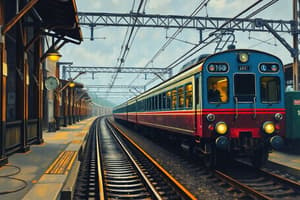Podcast
Questions and Answers
What is the minimum length a track circuit should cover?
What is the minimum length a track circuit should cover?
- 26 meters (correct)
- 30 meters
- 15 meters
- 18 meters
In RE areas, which type of track circuit is used for D.C track circuits?
In RE areas, which type of track circuit is used for D.C track circuits?
- Single Rail track circuit (correct)
- Double Rail track circuit
- Triple Rail track circuit
- Quadruple Rail track circuit
Which of the following is NOT a requirement for glued joints in track circuits?
Which of the following is NOT a requirement for glued joints in track circuits?
- Testing before insertion
- Removal of rough edges and burrs
- Square and true rail ends
- Use of a special adhesive (correct)
What is the maximum distance allowed between staggered joints in track circuits?
What is the maximum distance allowed between staggered joints in track circuits?
What is the required clearance from the foot of the rail to the ballast in track-circuited sections?
What is the required clearance from the foot of the rail to the ballast in track-circuited sections?
What should be ensured to avoid flooding of tracks during rains?
What should be ensured to avoid flooding of tracks during rains?
Which of the following is a requirement for track relays?
Which of the following is a requirement for track relays?
Which tracks should ideally be connected in series for track circuits?
Which tracks should ideally be connected in series for track circuits?
What must be kept free from foreign materials at rail ends?
What must be kept free from foreign materials at rail ends?
What should be provided to prevent the crushing of end posts due to creep?
What should be provided to prevent the crushing of end posts due to creep?
Which type of sleepers can be used for track circuiting?
Which type of sleepers can be used for track circuiting?
What is the minimum resistance required for concrete sleepers?
What is the minimum resistance required for concrete sleepers?
How should short welded rail panels be arranged with respect to insulated joints?
How should short welded rail panels be arranged with respect to insulated joints?
Where should track relays ideally be located?
Where should track relays ideally be located?
What measures can be taken if relays are subjected to vibration?
What measures can be taken if relays are subjected to vibration?
What type of connections should be made between track relays and track repeating relays?
What type of connections should be made between track relays and track repeating relays?
What color light indicates that the line is occupied at other stations?
What color light indicates that the line is occupied at other stations?
What is the maximum allowable excitation for QBAT Relays?
What is the maximum allowable excitation for QBAT Relays?
Which type of track relay is specified for future installations?
Which type of track relay is specified for future installations?
What is the minimum percentage of rated pick up voltage required for exciting a DC track relay?
What is the minimum percentage of rated pick up voltage required for exciting a DC track relay?
What is the requirement for track relays used in conjunction with Q series track relay?
What is the requirement for track relays used in conjunction with Q series track relay?
What is the maximum allowed resistance for rail and bond up to a length of 700 meters?
What is the maximum allowed resistance for rail and bond up to a length of 700 meters?
What is the minimum distance required between track circuit termination and the Fouling Mark?
What is the minimum distance required between track circuit termination and the Fouling Mark?
Where should insulated rail joints ideally not be placed?
Where should insulated rail joints ideally not be placed?
What is the purpose of cut section track circuits when the track relays are de-energized?
What is the purpose of cut section track circuits when the track relays are de-energized?
What should be ensured before installing an insulated joint?
What should be ensured before installing an insulated joint?
How should the lugs of impedance bond connections be fixed?
How should the lugs of impedance bond connections be fixed?
What is the minimum spacing for existing yards between tracks according to laid down dimensions?
What is the minimum spacing for existing yards between tracks according to laid down dimensions?
Who is responsible for the installation of glued rail joints?
Who is responsible for the installation of glued rail joints?
What is the reason for avoiding hammer driving of fish-bolts?
What is the reason for avoiding hammer driving of fish-bolts?
What must be done if an end-post projects above the rail before the first train passes over it?
What must be done if an end-post projects above the rail before the first train passes over it?
What adjustment can be made regarding the distance between the insulated block joint and the starter signal for signaled movements?
What adjustment can be made regarding the distance between the insulated block joint and the starter signal for signaled movements?
Where should the insulation joint be placed in a point track circuit?
Where should the insulation joint be placed in a point track circuit?
How do track indicators function at panel interlocked or route relay interlocked stations when the line is unoccupied?
How do track indicators function at panel interlocked or route relay interlocked stations when the line is unoccupied?
What color of light do track indicators display when action is taken to set a route in an unoccupied area?
What color of light do track indicators display when action is taken to set a route in an unoccupied area?
What indication is shown on the panel if any portion of the track circuited area is occupied?
What indication is shown on the panel if any portion of the track circuited area is occupied?
In relation to glued joint portions of track, what type of clip should be used?
In relation to glued joint portions of track, what type of clip should be used?
What is the required characteristic of track circuits in terms of ballast resistance during wet weather conditions?
What is the required characteristic of track circuits in terms of ballast resistance during wet weather conditions?
In the context of feed mechanisms for track circuits, what must be provided separately for each track circuit?
In the context of feed mechanisms for track circuits, what must be provided separately for each track circuit?
Which of the following elements is NOT part of the maintenance requirements for DC track circuits?
Which of the following elements is NOT part of the maintenance requirements for DC track circuits?
What is the ideal state of the circuit regarding over-energization?
What is the ideal state of the circuit regarding over-energization?
What type of cells are approved for use in feeding track circuits?
What type of cells are approved for use in feeding track circuits?
Which of the following materials is critical for keeping the surface of the rail clean in track circuits?
Which of the following materials is critical for keeping the surface of the rail clean in track circuits?
What is the limiting resistance in the context of track circuit maintenance?
What is the limiting resistance in the context of track circuit maintenance?
In track circuits, what does the term 'RE' signify regarding the type of wooden block used?
In track circuits, what does the term 'RE' signify regarding the type of wooden block used?
Flashcards
Track Circuit
Track Circuit
A closed electrical circuit installed on railway tracks to detect the presence of a train.
Double Rail Track Circuit
Double Rail Track Circuit
A track circuit used on non-RE areas that uses two rails for the circuit.
Minimum Track Circuit Length
Minimum Track Circuit Length
The length of the track circuit needs to be at least the maximum wheelbase of a vehicle and at least two rail lengths (26 meters).
Insulated/Glued Joints
Insulated/Glued Joints
Signup and view all the flashcards
Staggered Joints
Staggered Joints
Signup and view all the flashcards
Rail End Requirements
Rail End Requirements
Signup and view all the flashcards
Track Drainage
Track Drainage
Signup and view all the flashcards
Ballast Maintenance
Ballast Maintenance
Signup and view all the flashcards
Insulated rail joints
Insulated rail joints
Signup and view all the flashcards
Anti-creep devices
Anti-creep devices
Signup and view all the flashcards
Track relays
Track relays
Signup and view all the flashcards
Location of track relays
Location of track relays
Signup and view all the flashcards
Cross protection
Cross protection
Signup and view all the flashcards
Double cutting arrangements
Double cutting arrangements
Signup and view all the flashcards
Insulated sleepers
Insulated sleepers
Signup and view all the flashcards
Multiple Track Circuit Sections
Multiple Track Circuit Sections
Signup and view all the flashcards
Track Circuit Indicator Lights
Track Circuit Indicator Lights
Signup and view all the flashcards
Adjustable Limiting Resistance
Adjustable Limiting Resistance
Signup and view all the flashcards
Track Relay Excitation
Track Relay Excitation
Signup and view all the flashcards
Track Circuit Termination Distance
Track Circuit Termination Distance
Signup and view all the flashcards
Minimum Distance to Fouling Mark
Minimum Distance to Fouling Mark
Signup and view all the flashcards
Cut Section Track Circuits
Cut Section Track Circuits
Signup and view all the flashcards
Insulated Rail Joint Placement
Insulated Rail Joint Placement
Signup and view all the flashcards
Rail Bonding Resistance
Rail Bonding Resistance
Signup and view all the flashcards
Fouling Mark
Fouling Mark
Signup and view all the flashcards
Bond Connection Lugs
Bond Connection Lugs
Signup and view all the flashcards
Fish Bolt Insertion
Fish Bolt Insertion
Signup and view all the flashcards
End-Post Leveling
End-Post Leveling
Signup and view all the flashcards
Insulated Block Joint Distance
Insulated Block Joint Distance
Signup and view all the flashcards
Insulated Block Joint Placement
Insulated Block Joint Placement
Signup and view all the flashcards
Point Track Circuit Insulation
Point Track Circuit Insulation
Signup and view all the flashcards
Track Indicator - Unoccupied
Track Indicator - Unoccupied
Signup and view all the flashcards
Track Indicator - Occupied
Track Indicator - Occupied
Signup and view all the flashcards
Track Indicator - Cleared
Track Indicator - Cleared
Signup and view all the flashcards
Track Circuit Feed
Track Circuit Feed
Signup and view all the flashcards
Track Circuit Maintenance
Track Circuit Maintenance
Signup and view all the flashcards
Ballast Resistance
Ballast Resistance
Signup and view all the flashcards
Insulating Joints
Insulating Joints
Signup and view all the flashcards
Track Circuit Over-energization
Track Circuit Over-energization
Signup and view all the flashcards
Shunting Value
Shunting Value
Signup and view all the flashcards
Track Circuit Types (RE/Non-RE)
Track Circuit Types (RE/Non-RE)
Signup and view all the flashcards
Track Circuit Resistance (Ohms)
Track Circuit Resistance (Ohms)
Signup and view all the flashcards
Study Notes
Track Circuits General
- Closed type track circuits are required to verify rail track clearance.
- Double rail track circuits are needed in non-RE areas; single rail for DC and double rail for AFTC in RE areas.
- Minimum track circuit length must be at least the maximum wheelbase of any vehicle, covering at least two rail lengths (26 meters).
- Track sections should be connected in series.
- Approved track relays are required.
Permanent Way Requirements of Track Circuits
- Glued or insulated joints are used to define track circuit boundaries. Insulated joints are preferred in new work.
- Joints should be tested before installation.
- Staggered joints must not exceed the minimum vehicle wheelbase.
- Rail ends of joints must be square and true, with removed rough edges/burrs.
- Fish bolts must be tight and sleepers firmly packed.
- Proper drainage, including washable aprons for watering and rainy conditions, is needed.
- Ballast must be clean, cleared from rails and fastenings, and at least 50 mm clearance is maintained.
Installation of DC Track Circuits
- Track relays are positioned at entry points of track circuits.
- Relays can be in approved locations in cabins or relay rooms if not in the cabin.
- Anti-vibration mounts (e.g., rubber pads, foam) may be needed.
- Proper wiring diagrams and cross-protection arrangements are required for connections.
- Separate feed and relay ends are connected by separate cables.
Jumper Connections
- Track circuit jumpers should be series-connected (excluding traction return rail) for effective operation.
- Jumper connections are preferably duplicated to prevent damage.
- Connections must be long enough to accommodate rail creep and should be firmly attached.
- Galvanized iron wire or cables with appropriate size are used for jumpers.
- Track-relay and feed wiring must use copper conductors with at least 2.5 sq mm cross-section.
Track Circuit Terminations
- Terminations are needed before the track fouling mark at stations, with at least 3m distance.
- When de-energized, cut-section circuits open track feed and shunt the track circuit.
- Adequate spacing should avoid vehicle infringement.
- Insulated rail joints shall conform to RDSO drawings and standards when installed.
- Insulated rail joints are not placed on outer rails in curves.
- Insulated rail joints minimize dead zones where standing vehicles are not detected.
Track Indicators
- Track indicators show no light if a line is unoccupied.
- Indication changes to yellow/white if a route is set and unoccupied.
- Indicator changes to red if any part of the track is occupied.
- Specific indicators are needed for berthing areas.
- Track indicators show yellow/white for unoccupied; red for occupied lines.
Track Relays
- DC track relays from approved manufacturers are used.
- Plug-in type relays (9 ohms) are preferred for new installations.
- Q series track relays require Q series slow-to-pick-up relays as repeaters.
- Relay excitation must be at least 125% of minimum rated value.
- Maximum excitation should not exceed 235% for QBAT or 300% for other relays.
Track Feed
- Approved secondary cells are used for feeding circuits.
- Battery chargers or solar panels provide adequate power.
- Separate feeds are required for each track circuit.
Maintenance of DC Track Circuits
- Connections between power, track, relays, and adjacent rails must be maintained.
- Ballast resistance values must remain high and not fall below specifications.
- Insulating joints must have a high resistance.
- Rail surfaces must be clean of foreign matter.
- Appropriate circuit energization is necessary in wet weather or low-resistance conditions.
- Switching of track relay connections helps prevent permanent magnetization.
Studying That Suits You
Use AI to generate personalized quizzes and flashcards to suit your learning preferences.




